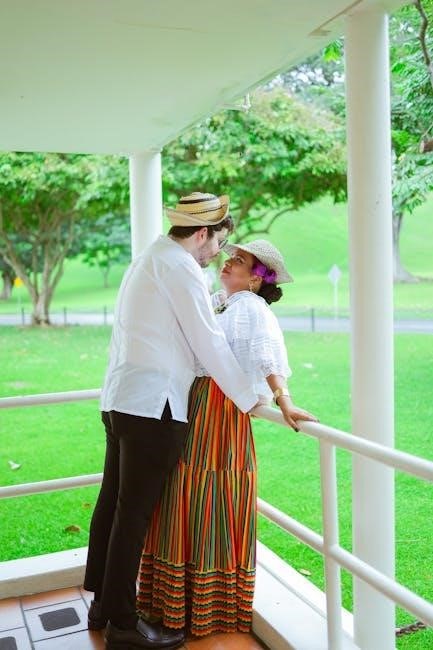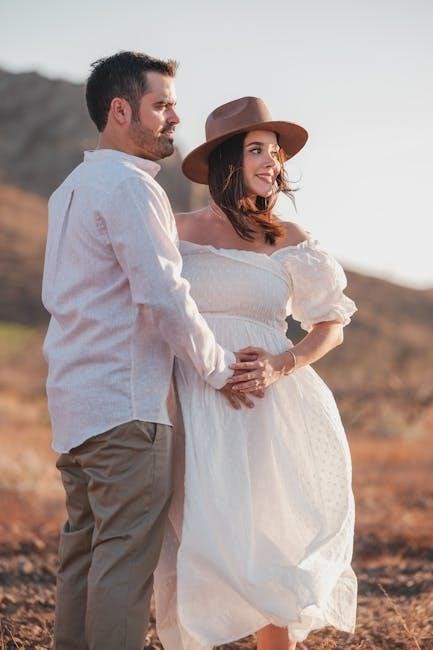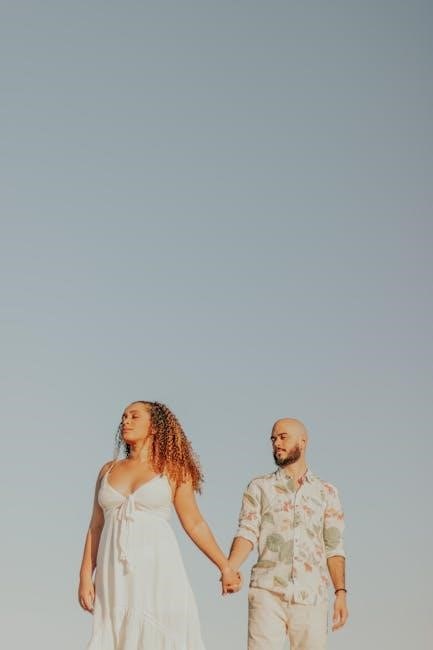A well-fitting dress shirt is essential for a polished look. This guide helps determine the perfect size, focusing on key measurements and fit types to ensure comfort and style.
Understanding the Importance of Proper Fit
A proper-fitting dress shirt enhances confidence, comfort, and style. It ensures a polished appearance, making you look sharp and put-together. A shirt that’s too tight restricts movement and feels uncomfortable, while one that’s too loose can appear sloppy. The right fit creates a balanced silhouette, complementing your body shape. Whether for professional settings or formal events, a well-fitting shirt is a cornerstone of a stylish outfit. Understanding your measurements and fit preferences is key to selecting a shirt that flatters and performs optimally, ensuring a professional and stylish impression every time.

Key Measurements for Determining Dress Shirt Size
Accurate measurements of neck, sleeve length, chest, and waist ensure a tailored fit. These metrics guide size selection, guaranteeing comfort and a flattering silhouette for every body type.
Neck Size: The Primary Measurement
Neck size is the most critical measurement for a dress shirt, as it determines the fit around the collar. To measure accurately, wrap a flexible tape around the base of your neck, just above the Adam’s apple, ensuring it’s level and not too tight. The measurement corresponds to the shirt’s collar circumference, typically ranging from 13 to 19 inches. A proper fit allows one finger to slip comfortably between the collar and neck. Incorrect sizing can lead to a collar that gaps or feels restrictive. This measurement is essential for both comfort and a polished appearance, forming the foundation of a well-fitting shirt.
Sleeve Length: Ensuring the Perfect Fit
Sleeve length is a crucial measurement for comfort and style. To measure accurately, place the tape measure from the center back of your neck, over your shoulder, and down to your wrist, with your arm slightly bent. Standard sleeve lengths range from 32 to 37 inches. A well-fitted sleeve should reach the base of your thumb when your arm is relaxed. If wearing a jacket, the shirt cuff should extend about half an inch beyond the jacket sleeve. Proper sleeve length ensures both a tailored appearance and ease of movement, making it a key factor in achieving a polished look.

Understanding Dress Shirt Fit Types
Understanding fit types is key to balancing style and comfort. Slim, Regular, and Relaxed fits cater to different body types, ensuring a tailored yet comfortable silhouette for every man.

Slim Fit: Modern and Tailored
A slim-fit dress shirt offers a contemporary, streamlined look designed for the modern man. It features a narrower cut through the chest, waist, and sleeves, creating a sharp silhouette. Ideal for slimmer builds or those seeking a fashionable appearance, slim-fit shirts minimize excess fabric for a sleek, polished look. The tailored design ensures a close fit without feeling restrictive, making it perfect for formal or semi-formal occasions. Pairing well with tailored suits, slim-fit shirts are a versatile choice for men who prefer a stylish, modern aesthetic while maintaining comfort and sophistication.
Regular Fit: Classic and Comfortable
A regular-fit dress shirt offers a timeless, classic style that balances comfort and elegance. Designed for a traditional silhouette, it provides a slightly looser fit than slim-fit shirts, making it suitable for men of all body types. The regular fit allows ease of movement while maintaining a polished appearance, perfect for formal and business casual settings. Its universal appeal makes it a versatile choice for everyday wear or special occasions, ensuring a comfortable yet stylish experience for the wearer.
Relaxed Fit: For a Looser Silhouette

A relaxed-fit dress shirt is designed for men who prefer a looser, more comfortable silhouette. It offers ample room in the chest, shoulders, and midsection, making it ideal for larger builds or those who value ease of movement. The relaxed fit is less tailored than slim or regular fits, providing a casual yet dignified appearance. It is perfect for men seeking a comfortable option without sacrificing style. This fit is particularly suitable for everyday wear or informal events, offering a balanced blend of comfort and versatility while maintaining a polished look.

Fabric Selection and Its Impact on Fit
Fabric selection significantly influences fit, with options like cotton, linen, and seersucker offering unique comfort, drape, and seasonal suitability, ensuring optimal style and comfort for every body type.
Common Fabrics and Their Characteristics
Cotton is the most popular fabric for dress shirts due to its softness, breathability, and durability. Linen is ideal for warm weather, offering a lightweight, textured feel. Seersucker, known for its striped pattern, is a casual option with a unique weave that keeps you cool. Oxford cloth, a versatile choice, features a subtle texture and is suitable for both formal and business casual settings. Each fabric type has distinct properties that affect comfort, appearance, and suitability for different occasions, making fabric selection a crucial part of choosing the perfect dress shirt.

Numerical Sizing Explained
Numerical sizing uses two numbers: the first indicates neck size, the second sleeve length, ensuring a precise fit for optimal comfort and style, making it easier to choose the right size.

How to Read and Use Size Charts
Reading a size chart involves matching your measurements to the corresponding numbers. Start by identifying your neck and sleeve measurements. Locate these numbers on the chart to find your size. Ensure accuracy by using a flexible tape measure. Compare your measurements to the chart’s numerical sizing, which typically includes neck size and sleeve length. If your measurements fall between sizes, consider your fit preference. Slim fit shirts may require a smaller size, while regular or relaxed fits offer more room. Always refer to the specific chart provided by the retailer for the most accurate fit. Sales associates can also assist if needed.

Cuff and Collar Styles
Cuff and collar styles significantly impact a dress shirt’s appearance. From barrel cuffs to spread collars, these elements enhance both functionality and aesthetic appeal, tailoring the shirt to suit various occasions.
Popular Cuff Styles for Dress Shirts
Dress shirts feature various cuff styles to suit different preferences and occasions. The barrel cuff is the most common, with a single button closure, offering a classic look. French cuffs are more formal, requiring cufflinks for a sophisticated appearance. Button cuffs resemble barrel cuffs but have visible buttons, adding subtle detail. Contrast cuffs, with differing fabrics or colors, create a stylish contrast. Each cuff style enhances the shirt’s versatility, allowing men to choose based on their personal taste and the formality of the event.
Collar Types and Their Suitability
Dress shirt collars come in various styles, each suited for different occasions and face shapes. The Oxford collar is classic and versatile, pairing well with ties and casual outfits. Spread collars are wider, ideal for larger ties and formal events. Wingtip collars are timeless and elegant, often paired with bow ties for a sophisticated look. Pointed collars are sleek and modern, complementing slim tie styles. Each collar type enhances the shirt’s aesthetic, ensuring a polished appearance that aligns with personal style and event formality.

A perfectly fitting dress shirt boosts confidence and versatility. Always measure accurately, choose quality fabrics, and consider your lifestyle. Experiment with styles to find your signature look effortlessly.
How to Ensure the Best Fit for Every Occasion
Ensuring the best fit for every occasion involves a combination of accurate measurements, understanding fit types, and selecting appropriate fabrics. Start by measuring your neck, chest, and sleeves to determine your size accurately. Consider the occasion—formal events may call for a slim-fit shirt with a spread collar, while casual gatherings might suit a regular-fit shirt with a button-down collar. Fabric choice matters too; opt for breathable cotton for everyday wear or linen for summer events. Utilize size charts and consider alterations for a polished look. Finally, know your body type to choose flattering styles, ensuring your shirt complements your physique and the event’s formality.
